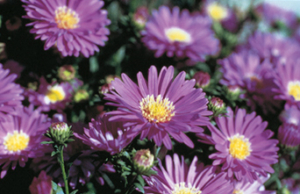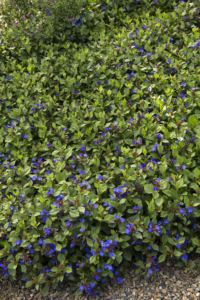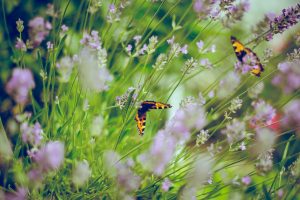Beautiful Late Summer, Early Fall Blooms for Your Garden
Ask any gardening professional to narrow down their favorite late summer blooming flowers in Utah and you’d better be ready to sit back and spend a few hours…probably best to have a cold beverage in hand too. There are so many beautiful plants that will keep blooming strong right up to winter. While we would love to list every single one of them here, it would be faster to read the entire Game of Thrones book series.
So, we shall give you a relatively short, but very sweet, list of late summer blooms that you can plant now, enjoy now, enjoy in the fall, and (as many of them are perennials or biennials) enjoy again next year. Yes, they are all that good.
Best Late Summer Blooming Flowers for Utah
-
Asters: Your Garden’s Star Performers
Asters have daisy-like flowers which bloom in late summer through fall. They come in a wide variety of colors and sizes, attract pollinators with their bright colors, and are disease and deer resistant. There is a wide variety of asters with colors that range from white and pastels of blues and pinks, to hybrids of deep scarlet and purple.
2. Plumbago: The Versatile Ground Hugger
An incredibly versatile groundcover for cold climates, Plumbago does well in both sun and shade and can handle most soil types very well. The blooms start in late summer with numerous, long-lasting, deep blue flowers. As the flowering finishes, the leaves change to a vivid mahogany red color, continuing their colorful display until winter.
3. Ornamental Oregano: Pretty and Practical
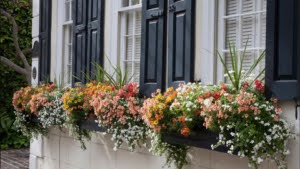
Though it is most commonly known for varieties that are used in cooking, Oregano has some ornamental varieties that are absolutely beautiful. These hardy perennial varieties do well in rock gardens as well as areas with well-drained soil. Ornamental oregano is an attractive flowering perennial that’s easy to grow. The flavor isn’t as strong as the culinary variety, but it has an unmatched appearance in its colorful bracts that develop in a host of pastel hues. We have seen Ornamental Oregano referred to as “a peacock of the herb family.” And while it is known to have the first heavy blooms appear in June through July, a heavy shearing in midsummer will

encourage another round of blooms in late summer through early fall.
4. Fall Anemone: Graceful Late Bloomers
Fall-blooming anemones bring an elegant touch of ethereal beauty to an autumn landscape with their delicate-looking flowers topping off the willowy stems. As the petals drop off the blossom, they leave behind a globe-shaped seed head, the combination of which provides a delightful showing for several weeks between late July and October, depending on the cultivar.
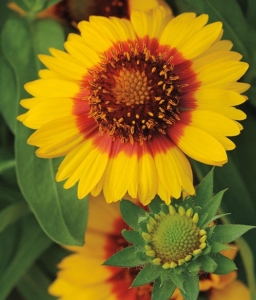 5. Gaillardia (Blanket Flower): The Season-Long Showoff
5. Gaillardia (Blanket Flower): The Season-Long Showoff
Also known as Blanket Flower, this powerhouse of a plant blooms from early summer right through the entire season. The flower is daisy-like, but the petal ends have a slightly ruffled appearance. These easy-to-grow perennials come in many colors from yellow to deep red and are most known for their showy, banded flowers. Gaillardia does well in hot, sunny gardens. Oh, and they happen to be a butterfly favorite.
12 More Perennial Options for Fall Blooms:
- Stella D’Oro Daylily
- Desert Four O’Clocks
- Gaura (Whirling Butterflies)
- Sundancer Daisy
- Rozanne Hardy Geranium
- Sedums (fall & creeping varieties)
- Goldenrod
- Coreopsis
- Toad Lily
- Hardy Hibiscus
- Salvia Greggii
- Add Hellebore now for winter blooms (yes, they bloom in winter! These are also known as Lenten Roses as they bloom during the season of Lent)
2 Biennial Fall Bloomers:
- Pansies
- Snapdragons
1 Annual Fall Bloomer:
Bonus A Glover Team favorite: Not for the flowers, but for the seed heads, we also recommend adding some perennial grasses like Miscanthus, Switchgrass, Bluestem, Grama – all of which offer color, texture, and movement to your garden from late summer through the winter months.
Planning Your Late Season Display
When choosing fall-blooming flowers for your garden, consider bloom times and plant heights. Place taller varieties like Echinacea and Fall Anemones toward the back of beds. Use shorter plants like Plumbago and creeping Sedums in front or as edging.
Care Tips for Extended Blooms
Most late summer flowers benefit from deadheading spent blooms. This encourages more flowers to form. Water deeply but less frequently to help plants develop strong root systems. Adding a layer of mulch around plants helps retain moisture and suppress weeds.
You can extend the blooming season even further by planting late summer flowers in containers. Pots allow you to move plants to ideal growing conditions as seasons change. They also let you refresh tired garden areas with instant color.
Creating Color Combinations
Mix flowers with different textures and bloom shapes for visual interest. Wispy grasses or the floating flowers of Gaura could make an elegant background structure fronted by more densely blooming perennials like Asters or Salvia Greggii, complemented by colorful creeping Sedum to accentuate the front border. Or play with the different varieties of tall yellow blooms, like Daylilies and Goldenrod, to complement the lower growing purples of Desert Four O’Clocks or Plumbago.
Working with complementary or contrasting colors from the color wheel makes designing your garden a breeze. Here’s a great resource from Proven Winners that breaks it down into easy peasy color schemes.
These gorgeous fall-blooming flowers offer something for every garden style and skill level. Whether you prefer formal borders or naturalized plantings, you can find varieties that suit your space and growing conditions.
What to Look for in Late Summer Blooming Flowers for Utah
Drought-Resistant Flowers
You need flowers that can handle Utah’s dry climate without constant watering. Look for plants with thick, waxy leaves or fuzzy foliage that help retain moisture. These traits show the plant can store water naturally.
Why drought-resistant matters:
- Saves money on water bills
- Reduces maintenance time
- Works better in Utah’s natural rainfall patterns
Some flowers have deep root systems that reach underground water sources. Others have succulent-like features that store water in their stems or leaves. Sedum creates colorful displays in Utah’s rocky areas with its water-storing leaves.
Signs of drought-resistant flowers:
- Silver or gray foliage – reflects heat and reduces water loss
- Small, narrow leaves – less surface area means less water evaporation
- Thick, fleshy stems – stores water for dry periods
- Deep taproot systems – reaches water deep in soil
Flowers for Growing Zone 5b to 7a
Your flower choices must survive Utah’s winter temperatures. Most of Utah falls between growing zones 5b and 7a, which means winter lows can drop to -10°F to 10°F. You can check the USDA Plant Hardiness map and enter your zip code to find your exact zone.
If you want perennials that come back each year after cold winters, you will want to pay attention to your growing zone. This saves you money and time replanting every spring. Check plant tags for zone ratings before you buy.
Temperature ranges by zone:
- Zone 5b: -10°F to -5°F winter lows
- Zone 6a: -5°F to 0°F winter lows
- Zone 6b: 0°F to 5°F winter lows
- Zone 7a: 5°F to 10°F winter lows
Plants rated for your specific zone or lower numbers will survive your winters. A zone 4 plant will thrive in zone 6, but a zone 8 plant might not survive.
Full-Sun Flowers
Utah gets intense sunlight, especially in late summer. You need flowers that love full sun conditions – at least 6 to 8 hours of direct sunlight daily.
Benefits of full-sun flowers in Utah:
- More blooms in intense sunlight
- Better heat tolerance
- Stronger stems and healthier growth
- Less prone to fungal problems in dry air
Look for plants described as “full sun” or “sun-loving” on plant tags. These will give you the best late summer color when other plants start to fade. At Glover Nursery these will be in our Sun Perennial section. Just ask one of our friendly associates to show you the way when you visit!
Late Summer Blooming Perennials
Native perennials create wild gardens where pollinators flourish during this important time of year. Butterflies and bees need late nectar sources before winter and, as grasses and perennials develop their seed heads, birds will also use them to keep their bellies full of nutrient dense food.
Choose perennials with long bloom periods that start in late July or August. Some will keep flowering until the first hard frost. Aster, for example, thrives in heat and blooms from late summer until late fall with more flowers in hotter weather.
What to look for:
- Bloom time listed as “late summer” or “fall”
- Long flowering periods (6+ weeks)
- Heat tolerance ratings
- Native or adapted varieties for your area
FAQ’s About Late Summer Blooming Flowers
What sturdy flowers thrive in Utah’s intense late summer sunshine?
Several tough flowers can handle Utah’s blazing late summer sun. Some local favorites outside of the already long list we recommend in this blog post would include Catmint, Lavender, Russian Sage, and Yarrow. You can see more options here.
Which perennial flowers provide late summer color year after year in Utah?
It is really difficult to make one list of all our favorite options for late summer color. 4 of our favorites are Asters, Coreopsis, Desert Four O’Clock and the Blanket Flower. If you have these in your garden you’ll have color in plants that can really handle the intensity of Utah conditions.
Asters top the list because they’re low-maintenance and come back stronger each year.
Coreopsis, also known as Tickseed, is an excellent option as it tends to re-seed, which can create natural drifts of color. Even in Utah’s intense summer heat, these plants keep blooming with minimal care.
Desert Four O’Clock offers something unique. These incredibly drought-tolerant native perennials abound with purple blooms from mid-summer through first frost. The flowers open in late afternoon and stay open through the night.
Blanket Flower (Gaillardia) provides vibrant red and yellow blooms that last from summer into fall and are a favorite of all the water-wise gardeners looking to create a colorful garden.
What are the best flower options for creating colorful late summer displays in Utah?
For maximum visual impact, focus on flowers that bloom in contrasting colors and heights. Sunflowers or Joe Pye Weed add dramatic height and bold color. Use different varieties of plants to create a garden with ever changing blooms, giving your garden visual interest all season long.
Which flowers typically bloom in Utah during August?
August brings peak blooming time for many late summer flowers. Summer perennials are still blooming strong while fall blooming perennials are starting to gear up for their time to shine. As we listed above, there are a few key players that we really love, but do not let this list stop you from exploring. Your local garden center will have dozens of options available that are seasonally appropriate. We often recommend wandering through the perennial section once per month to get a feel for what options you might want to add to your garden so you can see what blooms might be missing from your landscape..
What flower varieties bloom as September arrives in Utah?
September brings the final wave of late summer color before fall sets in.
A super star of the perennial kingdom is the Sundancer Daisy, also known as Sol Dancer, which is a drought tolerant power house that needs very little water while it blooms from spring through first frost.
And if you’ve never grown a Hardy Hibiscus….you haven’t lived! These tropical looking flowers appear to float above the foliage, pushing bloom after bloom from July until first frost. While they are very late to break dormancy, when they do, they grow almost overnight into their full form and once they start blooming right in the middle of summer, they put on the most spectacular show.
Anemone shine during this month, with all varieties hitting their peak bloom. Guara is fully in stride. Plumbago is not only blooming but also the foliage is transforming from green into deep burgundy, Stella D’Oro lilies are still sending out those delightful golden flowers,
Mums (Chrysanthemums) begin their fall display in late August and hold strong through September. Choose hardy varieties that can handle Utah’s temperature swings, but prune them in mid-summer to push the fall blooms. Alternatively, pop in a few annual varieties to give you a giant ball of beautiful color through the end of fall, right into winter.
Sedum varieties like Autumn Joy start blooming in September with pink flowers that darken as fall progresses. And while the blossoms might be done on creeping Sedum, the color of the foliage is still as intriguing as the blossoms themselves.
Some Coreopsis varieties continue blooming into September, especially if you’ve kept them deadheaded through summer.
Annuals like Pansies or Snapdragons are a wonderful way to bring vibrant color to the landscape, both of which are known to survive winter and either re-seed or re-bloom for another season (or two).
Fall-blooming crocuses emerge in late September, providing unexpected bursts of purple and white color before winter arrives.
Explore More Late Summer Blooms for Utah
There are more — so many more — but this is a great list if you are looking for that flower power to add some pop to your garden now.
If these late-summer through fall stunners aren’t enough to satisfy your thirst for color, explore our guide to the top ten end of summer blooms for Utah.
Now, if neither of these lists is enough to get the garden color you are seeking, come on down and we’ll show you the many more options available – after all, we are here to help and we have hundreds of beautiful plants in stock with more arriving every week. It’s a good time to be at Glover Nursery.
Visit us at 9275 South 1300 West
See you soon!
